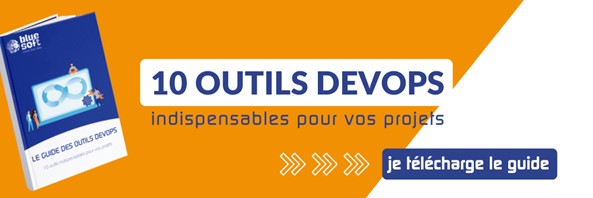UX/UI trends for 2021 to test urgently!
27/07/2021
8min
What are the UX/UI trends of 2021 that you should urgently test?
In an increasingly competitive web ecosystem, it is essential to take care of the user experience of websites and mobile applications. As a result, UX/UI are nowadays essential levers to optimize the customer experience.
Pour rappel, l’UX (User Experience) désigne l’expérience globale de l’utilisateur. Elle englobe l’ensemble des moyens déployés pour concevoir une interface répondant aux besoins de ce dernier. L’UI (User Interface), elle, est une branche de l’UX : l’interface utilisateur. Là où l’UX se concentre sur le fonctionnement global des interfaces, l’UI s’intéresse à l’aspect visuel. Ainsi, l’UI vise à attirer le regard du visiteur et faciliter sa navigation pour l’inciter à s’engager. Lisez notre article « L’expérience utilisateur doit être au centre de la stratégie des DSI ».
Welcome to the world of UX/UI, a field in constant evolution: UX Writing, biometrics, Security by design, Glassmorphism advanced micro-interactions, Neuromorphism and evenartificial intelligence are strong trends for the year 2021.
The main graphic trends of the UI in 2021
UX Writing
UX Writing refers to the editorial dimension of UX. It is the texts written to improve the visitor's experience on the entire site. The idea here, unlikecopywriting or web writing, is not to convince, sell or bring value to the reader, but to :
- to make his journey on the site more fluid;
- facilitate understanding and accessibility;
- personalize the experience to generate affection around a brand, a product or a service.
Here is a case study from TripAdvisor illustrating UX Writing:
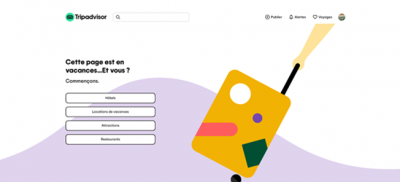
The 404 page of the TripAdvisor website
Glassmorphism
The Glassmorphism is one of the most noticed graphic trends of 2021. It gets its name from the effect it produces, like the surface of a glass screen. Glassmorphism is easily identifiable because it relies on transparency, floating objects, sharp contours and sharp colors. The goal is to trigger a "wow" effect in the user.
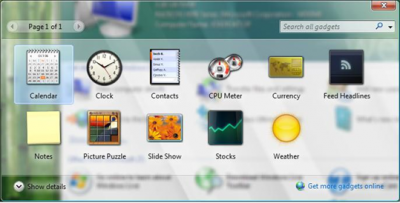
Microsoft is one of the first major Internet players to take up Glassmorphism with Windows Vista in 2007
Neumorphism Design
The Neumorphism is another trend in the user interface. It aims to provide a relief effect, creating very realistic elements in a sober style. Neumorphism differs from other graphic trends in several ways:
- clean design;
- some touches ofshadows ;
- few colors but a real coherence.
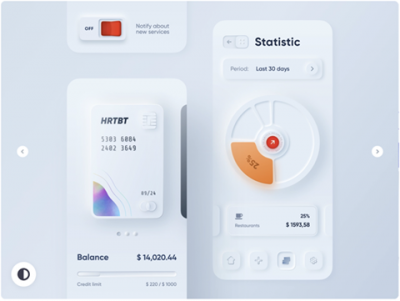
A design by Alexander Pluyto, pioneer of Neumorphism (source: Dribbble)
UX innovations to optimize the end-to-end user journey in 2021
Advanced micro-interactions
Micro-interactions represent all the moments when the user performs an action that leads to a specific response. On computers and mobile devices, the trend is to increase the number of micro-interactions within the user experience. They can be translated in many ways: advanced animations, polished transition effects, interactive content, etc.
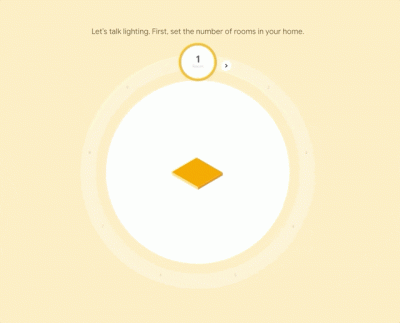
Example of interactive content on the Google site
Contactless interactions: Voice User Interface and airborne gesture control
The Covid-19 crisis has largely favored the trend of contactless interactions. To use a telling example, it is becoming difficult to force a user to manipulate a touch screen from a sales terminal. Thus, contactless interactions are on the rise. The concept of Voice User Interface (VUI) concept is based on voice control, thanks to voice interfaces. The voice search for a product on a cell phone is a good example: 25% of French people already use it. Another type of contactless interaction, less widespread for the moment, is developing: overhead gesture control. Based on the capture of movements, it emancipates itself from the physical contact and is therefore more efficient than any other type of interaction. Air gesture control is already starting to replace or complement traditional vehicle controls in some car manufacturers. In the same way, major cell phone brands are also taking advantage of this technology.
Simplification of accesses, connections, authentications
Account creation, authentication and login processes are central to UX and UI optimization. To make authentication more fluid, several methods tend to become more common in 2021:
- unified experience: a single identity for a seamless user experience;
- federation: a single password to unlock access to all applications via a third-party service, to put an end to the inconvenience associated with this process;
-
Authentication via push notifications: this multi-factor method uses different devices for a fast and secure connection.
Push notifications are particularly popular in the banking sector, to facilitate online transactions.
UX/UI trends in 2021 that make security a priority
Security by design
If the user experience serves the fluidity, accessibility and satisfaction of the visitor, one factor remains central: security, especially data security. The approach Security by design approach consists of integrating a process capable of guaranteeing the end user a totally secure experience of the product or service, right from the design stage of the project (website, application, etc.).
It is no longer a question of applying a security layer once the project is almost finished: security becomes the foundation of the design and all development is based on this architecture. This UX/UI trend puts security back at the heart of application development.
Biometrics: fingerprints, facial recognition, etc.
From fingerprints to dynamic user signatures, biometrics are becoming increasingly commonplace. This process is highly appreciated for its increased security, its tamper-proof nature and its easy deployment in the user path, while avoiding friction points.
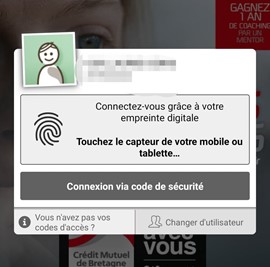
Example of biometric identification process by fingerprint on the mobile application of Crédit Mutuel de Bretagne
UX and AI: the emerging (and winning) duo of 2021
UX and AI share common goals: interpreting human behavior and anticipating their choices to better support them in their journey. So this alliance is not a surprise.
Artificial intelligence is already widely used to serve the UX. Its most popular forms are the creation of recommendation engines and the continuous improvement of conversational robots. However, the possibilities offered by artificial intelligence are not limited to that. Here are other applications of this technology that are expected to emerge in the future:
- Increase speed and reduce errors: by reducing the number of interactions required by the user through predictive algorithms, AI can smooth and optimize the user journey;
- UX data analysis and panoramic details: AI, thanks to its prodigious computing power, offers the possibility of accurately analyzing the behavior of a platform's users (bounce rate, pages visited, etc.) to automate recommendations;
- Time saving for humans: the automation of repetitive tasks thanks to AI is an additional opportunity to invest in jobs that require a human and creative presence, which includes UX.
In short, UX and UI are not just a question of aesthetics: they allow us to stand out in a very competitive world and to optimize the user experience. UX and UI are powerful levers of innovation that must be at the heart of an organization's global strategy.
Interested in this subject? Read our article on our remote UX/UI workshops with CCI France Internationale
Looking to perfect the UX/UI of your solution? Consult the specialists of our agency " Le Renard Bleu "to discuss the levers for optimizing your user experience!
Would you like to join us? Read the testimonial from Charlotte, UX Designer at Le Renard Bleu
UX/UI trends for 2021 to test urgently!
27/07/2021
8min
What are the UX/UI trends of 2021 that you should urgently test?
In an increasingly competitive web ecosystem, it is essential to take care of the user experience of websites and mobile applications. As a result, UX/UI are nowadays essential levers to optimize the customer experience.
Pour rappel, l’UX (User Experience) désigne l’expérience globale de l’utilisateur. Elle englobe l’ensemble des moyens déployés pour concevoir une interface répondant aux besoins de ce dernier. L’UI (User Interface), elle, est une branche de l’UX : l’interface utilisateur. Là où l’UX se concentre sur le fonctionnement global des interfaces, l’UI s’intéresse à l’aspect visuel. Ainsi, l’UI vise à attirer le regard du visiteur et faciliter sa navigation pour l’inciter à s’engager. Lisez notre article « L’expérience utilisateur doit être au centre de la stratégie des DSI ».
Welcome to the world of UX/UI, a field in constant evolution: UX Writing, biometrics, Security by design, Glassmorphism advanced micro-interactions, Neuromorphism and evenartificial intelligence are strong trends for the year 2021.
The main graphic trends of the UI in 2021
UX Writing
UX Writing refers to the editorial dimension of UX. It is the texts written to improve the visitor's experience on the entire site. The idea here, unlikecopywriting or web writing, is not to convince, sell or bring value to the reader, but to :
- to make his journey on the site more fluid;
- facilitate understanding and accessibility;
- personalize the experience to generate affection around a brand, a product or a service.
Here is a case study from TripAdvisor illustrating UX Writing:

The 404 page of the TripAdvisor website
Glassmorphism
The Glassmorphism is one of the most noticed graphic trends of 2021. It gets its name from the effect it produces, like the surface of a glass screen. Glassmorphism is easily identifiable because it relies on transparency, floating objects, sharp contours and sharp colors. The goal is to trigger a "wow" effect in the user.

Microsoft is one of the first major Internet players to take up Glassmorphism with Windows Vista in 2007
Neumorphism Design
The Neumorphism is another trend in the user interface. It aims to provide a relief effect, creating very realistic elements in a sober style. Neumorphism differs from other graphic trends in several ways:
- clean design;
- some touches ofshadows ;
- few colors but a real coherence.

A design by Alexander Pluyto, pioneer of Neumorphism (source: Dribbble)
UX innovations to optimize the end-to-end user journey in 2021
Advanced micro-interactions
Micro-interactions represent all the moments when the user performs an action that leads to a specific response. On computers and mobile devices, the trend is to increase the number of micro-interactions within the user experience. They can be translated in many ways: advanced animations, polished transition effects, interactive content, etc.

Example of interactive content on the Google site
Contactless interactions: Voice User Interface and airborne gesture control
The Covid-19 crisis has largely favored the trend of contactless interactions. To use a telling example, it is becoming difficult to force a user to manipulate a touch screen from a sales terminal. Thus, contactless interactions are on the rise. The concept of Voice User Interface (VUI) concept is based on voice control, thanks to voice interfaces. The voice search for a product on a cell phone is a good example: 25% of French people already use it. Another type of contactless interaction, less widespread for the moment, is developing: overhead gesture control. Based on the capture of movements, it emancipates itself from the physical contact and is therefore more efficient than any other type of interaction. Air gesture control is already starting to replace or complement traditional vehicle controls in some car manufacturers. In the same way, major cell phone brands are also taking advantage of this technology.
Simplification of accesses, connections, authentications
Account creation, authentication and login processes are central to UX and UI optimization. To make authentication more fluid, several methods tend to become more common in 2021:
- unified experience: a single identity for a seamless user experience;
- federation: a single password to unlock access to all applications via a third-party service, to put an end to the inconvenience associated with this process;
-
Authentication via push notifications: this multi-factor method uses different devices for a fast and secure connection.
Push notifications are particularly popular in the banking sector, to facilitate online transactions.
UX/UI trends in 2021 that make security a priority
Security by design
If the user experience serves the fluidity, accessibility and satisfaction of the visitor, one factor remains central: security, especially data security. The approach Security by design approach consists of integrating a process capable of guaranteeing the end user a totally secure experience of the product or service, right from the design stage of the project (website, application, etc.).
It is no longer a question of applying a security layer once the project is almost finished: security becomes the foundation of the design and all development is based on this architecture. This UX/UI trend puts security back at the heart of application development.
Biometrics: fingerprints, facial recognition, etc.
From fingerprints to dynamic user signatures, biometrics are becoming increasingly commonplace. This process is highly appreciated for its increased security, its tamper-proof nature and its easy deployment in the user path, while avoiding friction points.

Example of biometric identification process by fingerprint on the mobile application of Crédit Mutuel de Bretagne
UX and AI: the emerging (and winning) duo of 2021
UX and AI share common goals: interpreting human behavior and anticipating their choices to better support them in their journey. So this alliance is not a surprise.
Artificial intelligence is already widely used to serve the UX. Its most popular forms are the creation of recommendation engines and the continuous improvement of conversational robots. However, the possibilities offered by artificial intelligence are not limited to that. Here are other applications of this technology that are expected to emerge in the future:
- Increase speed and reduce errors: by reducing the number of interactions required by the user through predictive algorithms, AI can smooth and optimize the user journey;
- UX data analysis and panoramic details: AI, thanks to its prodigious computing power, offers the possibility of accurately analyzing the behavior of a platform's users (bounce rate, pages visited, etc.) to automate recommendations;
- Time saving for humans: the automation of repetitive tasks thanks to AI is an additional opportunity to invest in jobs that require a human and creative presence, which includes UX.
In short, UX and UI are not just a question of aesthetics: they allow us to stand out in a very competitive world and to optimize the user experience. UX and UI are powerful levers of innovation that must be at the heart of an organization's global strategy.
Interested in this subject? Read our article on our remote UX/UI workshops with CCI France Internationale
Looking to perfect the UX/UI of your solution? Consult the specialists of our agency " Le Renard Bleu "to discuss the levers for optimizing your user experience!
Would you like to join us? Read the testimonial from Charlotte, UX Designer at Le Renard Bleu

